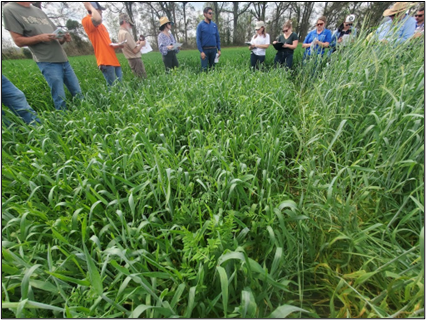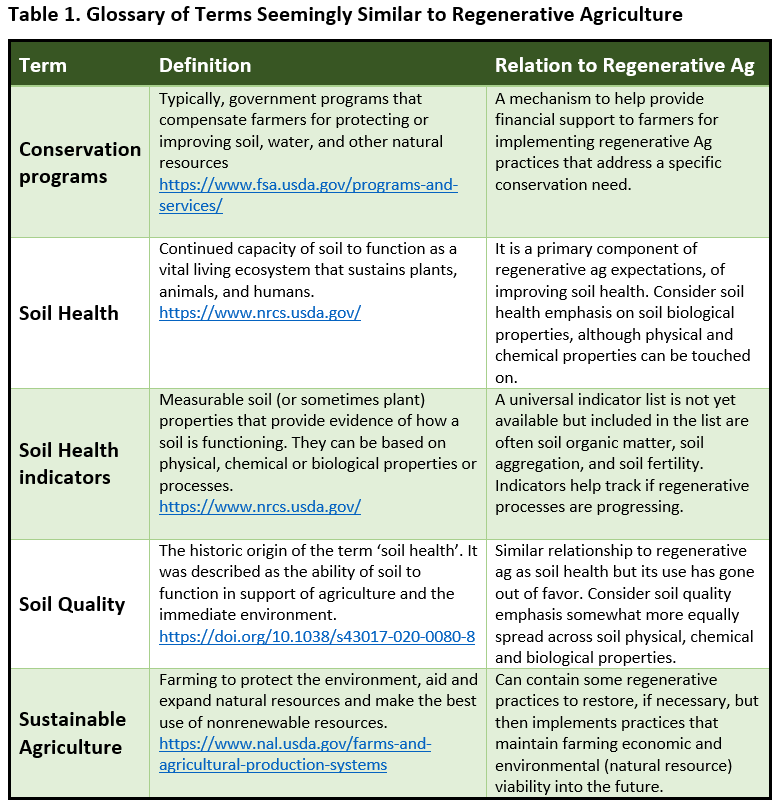Agriculture seems to be changing at an ever-swifter pace in terms of technologies and even terminology. This article will 1) define “Regenerative Agriculture” or Regenerative Ag, 2) how it compares to other similarly used terms, and 3) how Florida farm managers might capitalize on it.

Figure 1. Assessing cover crop options for use on dairies to protect water resources. Credit: Cheryl Mackowiak, UF/IFAS
J.I. Rodale, a New York entrepreneur from New York, suffered chronic health problems and in 1940, bought an old farm in Pennsylvania to learn how to grow food without chemicals or as he coined “organic production.” The farm eventually morphed into the globally known by the organic community as the Rodale Institute. Rodale’s son coined the term “regenerative organic agriculture” in the 1980s to distinguish farming practices that go beyond “sustainable,” to also improve the resources used to produce crops. Today, regenerative ag can apply to all agricultural practices, not solely organic practices (right).
As evidenced by the term’s origin, a concise definition was never established. Newton et al. (2020) performed a meta-analysis (review) of peer reviewed publications of scholar and practitioner definitions to determine if some standardization has happening since. They sampled over 250 articles and practitioner websites and found about half provided some type of definition or description. From there, they reviewed what outcomes were to be expected from regenerative ag practices. The greatest representative outcome across the survey was to improve “soil health” (structure, organic matter, and fertility), where approximately 40% of research articles and 85% of practitioner websites (PWs) addressed this. The next highest change was to increase biodiversity (22% of research papers and 45% of PWs). In comparison, increasing soil carbon was addressed only 17% by research papers and 64% by PWs. Other expected impacts were surprisingly not reported as frequently. For example, maintaining or improving farm productivity was reported only 15% in research papers and 23% in PWs. Reducing greenhouse gas emissions were represented even less, at 4% in research papers and 14% in PWs. A concern over societal social and economic wellbeing was reported 17% in research papers and over 40% by PWs. Finally, to lessen our food production footprint by developing circular production systems or reducing waste more generally, was reported 12% by research papers and less than 5% by PWs. This is interesting, since it seems that regenerative ag practitioners seem interested in sustainable production and reduced waste.
There are a few other terms that may be confused with or overlap with regenerative ag. A short glossary, including how they relate to regenerative ag is provide below (Table 1). Understanding the terminology provides a sound basis for leveraging your knowledge in preparation for various economic opportunities that may otherwise be unrealized. For example, a farm that can develop plans and goals (nutrient management, land management, etc.) will be prepared when state and federal government conservation and water quality programs solicit for cost-share and other subsidy opportunities. Carbon credit programs can also be a source of supporting funds, particularly if you can demonstrate a plan that will result in appreciable increases in land carbon stocks or reduced greenhouse gas emissions. Working with your county extension agent and USDA-NRCS local office, for example, can get you connected with agricultural economic opportunities you might otherwise have missed. It is another way of helping to keep farming viable in Florida.

Links from Table1. Conservation Programs, Soil Health, Soil Heath Indicators, Soil Quality, and Sustainable Agriculture
–
Reference:
Newton, P., N. Civita, L. Frankel-Goldwater, K. Bartel, and C. Johns. 2020. What is regenerative agriculture? A review of scholar and practitioner definitions based on processes and outcomes. Frontiers in Sustainable Food Systems. 20:577723.
- Grower Survey Insights on Cotton Nitrogen Management in Florida’s Panhandle - July 18, 2025
- Florida Soils are an Indispensable Natural Resource - January 10, 2025
- Regenerative Agriculture: What it Means to You - June 21, 2024
